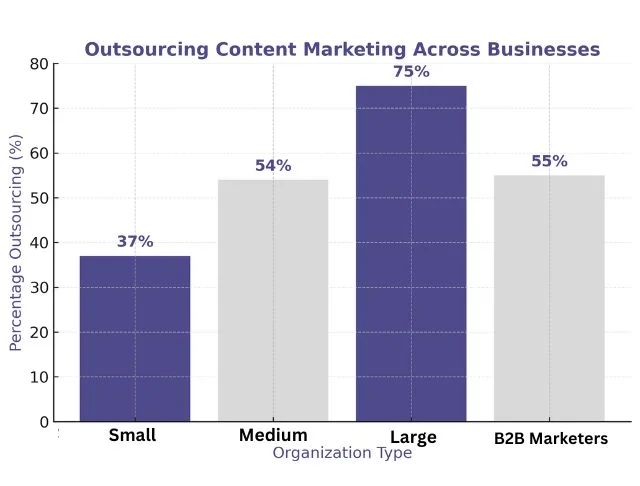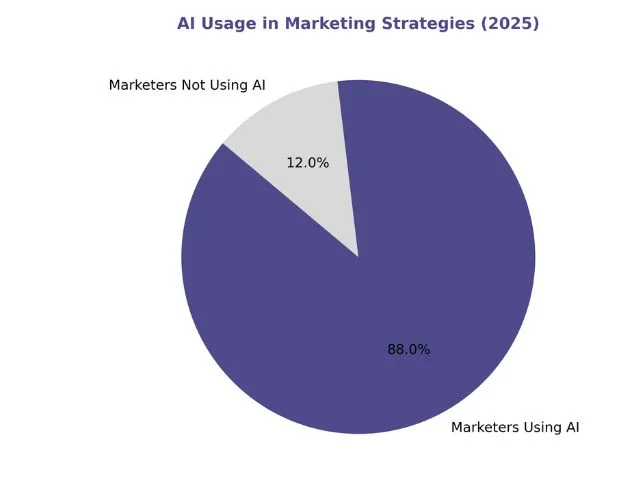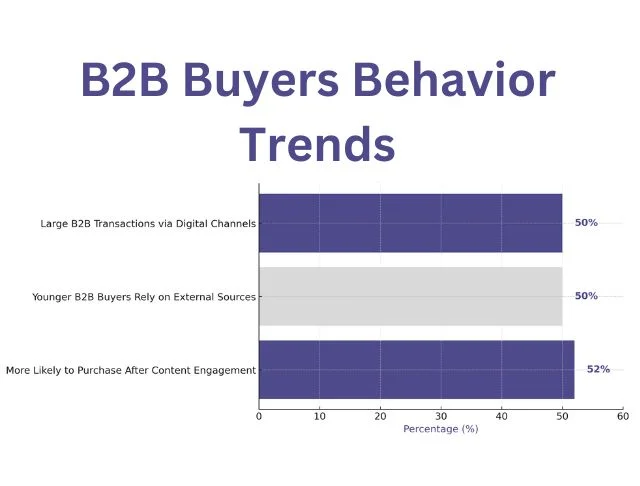by Abdullah Faraz
February 23, 2025
Nearly 80% of small business owners handle their own content marketing, primarily due to budget constraints. Only 17% hire in-house writers, and even fewer (14%) hire freelancers.1
However, content marketing remains one of the most popular strategies in 2025. While outsourcing is less common among small businesses, most medium- and large-sized businesses prefer hiring marketing agencies or freelancers.
To know more interesting statistics about content marketing, keep on reading.
- Content Marketing Stats (Top Picks)
- Content Marketing Effectiveness and Usage
- Marketing Outsourcing and Budgets
- Digital Trends and Technology Usage
- Mobile and User Behavior
- Customer Preferences and Engagement
- Social Media and Traffic
- Content Formats and Impact
- B2B and Marketing Insights
- Conversion and Customer Loyalty
Content Marketing Stats (Top Picks)
- 49% of small businesses rate their content marketing performance as effective
- 28% of content marketing campaigns succeed
- 72% of businesses report that content marketing boosts lead generation
- 90% of businesses use content marketing to generate sales
- Businesses that blog experience a 165% increase in lead growth
- B2B marketers anticipate an increase in their content marketing budgets by up to 46%
- 88% of marketers use AI in their marketing strategies in 2025
- 44% of businesses utilize SEO as part of their marketing strategies
- 40% of global companies are currently using AI in their operations
- 92% of internet users use mobile and over 60% of traffic comes from mobile
- 76% of shoppers abandon slow sites
- 376.5 billion emails are sent and received per day
- 91% of consumers prefer visual content to written content
- 77% of internet users still read blogs
- 80% of listeners listen to all or most of every podcast episode they start
- Only 16% of website traffic comes from social media
- 50% of marketers report using influencer marketing
- 87% of marketers claim that video has directly increased their sales
- Interactive content generates 52.6% more engagement than static content
- 52% of B2B buyers are “definitely” more likely to make a purchase after engaging with content
- 55% of marketers identify blog content creation as their highest priority for inbound marketing
Content Marketing Effectiveness and Usage
How many small businesses think they effectively use content marketing?
According to recent data, around 49% of small businesses rate their content marketing performance as “effective”. While 11% consider their content marketing “very effective”.
However, the effectiveness of content marketing largely depends on the content strategy and the marketer’s level of expertise.
Source: Adam Connell
What is the success rate of content marketing?

Nearly 28% of content marketing campaigns succeed. This shows there is a high demand for expert content marketing and opportunities for businesses to focus on content marketing because 72% of businesses report that content marketing boosts lead generation.
Companies with successful content marketing strategies prioritize improving content quality (55%), optimizing for SEO (46%), and incorporating video and other visual content formats (41%).
Source: NYT Licensing, SEO
What percentage of businesses use content marketing?
Approximately 90% of businesses use content marketing to generate sales. In addition, content marketing costs 62% less than traditional marketing channels, and of these leads, they are 6 times as likely to convert.
Source: Demand Metric
What percentage of businesses have a blog?
According to Demand Metric, 90% of businesses have a blog and use content in their marketing campaigns in 2025. In addition, Businesses that blog experience a 165% increase in lead growth, significantly higher than the 73% lead growth seen by companies that don’t blog.
Source: Demand Metric, Hubspot
Marketing Outsourcing and Budgets
What percentage of companies outsource their marketing?

Outsourcing content marketing is common across businesses of all sizes: 37% of small organizations, 54% of medium-sized organizations, and 75% of large organizations outsource some portion of their efforts. Additionally, 55% of B2C marketers rely on outsourcing for their content marketing needs.
Source: Content Marketing Institute
What is the average budget for content marketing?
The average budget for content marketing varies significantly based on the size of the business. Here are the key figures for 2025:
Small Businesses: Typically allocate between $4,000 to $10,000 per month for content marketing efforts.
Medium-sized Businesses: Generally spend between $10,000 to $40,000 per month.
Enterprise-level Businesses: Can expect to invest anywhere from $40,000 to over $60,000 per month on content marketing initiatives
Additionally, many B2B marketers anticipate an increase in their content marketing budgets for 2025, with 46% expecting a rise and 41% expecting their budgets to remain the same.
Source: The Digital Elevator, Content Marketing Institute
What percentage of marketers use AI?

According to SurveyMonkey, 88% of marketers use AI in their marketing strategies in 2025. This statistic reflects a significant trend toward the adoption of AI technologies in the marketing sector, indicating that a majority of professionals are leveraging AI to enhance their strategies.
Digital Trends and Technology Usage
What percentage of businesses use SEO?
Approximately 44% of businesses utilize SEO as part of their marketing strategies. This statistic highlights the significant adoption of search engine optimization among companies.
According to OptinMonster, 70% of marketers say that SEO is their primary focus for content marketing, further underscoring its importance in digital marketing efforts.
Source: Webfx
What percentage of businesses use AI in 2025?
According to the latest data, 40% of global companies are currently using AI in their operations, while 82% are either actively using AI or exploring its potential applications within their organizations.
Source: Exploding Topics
Is the use of AI increasing?
The use of AI is indeed increasing significantly across various sectors. Here are some key statistics and trends that highlight this growth:
A recent survey by McKinsey indicates that AI adoption has risen from 50% to 72% among organizations, showcasing a substantial increase in the integration of AI technologies into business operations. B2C industries showed the biggest jump from 38% to 87%.
Source: Mckinsey
Mobile and User Behavior
What percentage of internet users use mobile?
As of 2025, 92% of internet users use mobile and over 60% of traffic comes from mobiles. This shows how important it is to optimize the web pages for mobile devices.
Source: Exploding Topics
How many mobile web users abandon pages if they don’t load within 10 seconds?
Liquid Web reports that 76% of shoppers abandon slow sites, with 43% getting frustrated if a site doesn’t load within 10 seconds and 22% abandoning the website entirely if the delay persists.
How many emails are sent per day?
376.5 billion emails are sent and received per day. These numbers indicate that email remains a crucial communication tool globally, with a significant volume of messages exchanged every day.
Source: Prosperity Media
Customer Preferences and Engagement
How many customers want personalized experiences?
A significant 71% of customers now expect personalized experiences, while 84% believe brands should create content that entertains, provides solutions, and keeps them engaged.
Source: Mckinsey
How many people prefer visual content?
91% of consumers prefer visual content to written content, highlighting a strong preference for visuals in communication and marketing strategies.
Among marketers, 95.2% say that visual content is important to their marketing strategy, with a notable percentage indicating that their strategies would be ineffective without it.
Source: Venngage
What percentage of people read blogs?

As of 2025, 77% of internet users still read blogs. This statistic indicates a strong engagement with blog content among the global online population.
This highlights the significant role that blogs play in providing information, entertainment, and insights to a vast audience online.
Source: Ahrefs
What percentage of people listen to podcasts?
41% of Americans aged 12 and older listen to podcasts on a monthly basis and 80% of listeners listen to all or most of every podcast episode they start.
Sources: Buzzsprout, Backlinko
Social Media and Traffic
What percentage of website traffic comes from social media?
Only 16% of website traffic comes from social media. LinkedIn accounts for more than 46% of all social media traffic to business websites.
However, social media is recognized as a leading marketing channel, with many businesses incorporating it into their campaigns.
Source: VWO
What percentage of the search market does Google hold?
Google has 89.74% market share in 2025. This shows how important and useful SEO is for businesses.
Google updates hit most of the time, affecting blogging websites that solely rely on content while businesses are safe and SEO is for them.
The second SEO adoption opportunity is for content that is published newly and never has been written or written but needs improvement more than half of it is currently in Google.
Source: Statcounter
What percentage of businesses use influencer marketing?
As of 2025, approximately 50% of marketers report using influencer marketing as part of their strategies. This statistic reflects the growing acceptance and reliance on influencers to enhance brand visibility and engagement.
Source: HubSpot
Content Formats and Impact
Do videos increase sales?
Videos significantly increase sales and have a strong impact on consumer purchasing decisions. 87% of marketers claim that video has directly increased their sales, demonstrating its effectiveness in driving purchasing decisions.
Source: Vidico
What is the CTR of a thumbnail?
Video thumbnails now appear in more than 25% of search results and achieve a click-through rate exceeding 60%. This data underscores the effectiveness of video thumbnails in attracting user engagement and driving traffic to video content.
Source: Milestone
How effective is interactive content?
Interactive content is highly engaging. Interactive content generates 52.6% more engagement than static content, leading to a remarkable 94% increase in views.
B2B and Marketing Insights
What are the statistics for B2B buyers?

52% of B2B buyers are “definitely” more likely to make a purchase after engaging with content.
More than 50% of younger B2B buyers are expected to rely on external sources, including social media and their value networks, to inform their purchasing decisions.
Additionally, over half of large B2B transactions (valued at $1 million or greater) will be processed through digital self-serve channels, such as vendor websites or marketplaces.
Source: Orange Owl Marketing, Forrester
Conversion and Customer Loyalty
What is a good inbound lead conversion rate?
A good inbound lead conversion rate typically falls between 2% to 5% across various industries. For B2B companies, the average conversion rate is reported to be around 2.9%.
55% of marketers identify blog content creation as their highest priority for inbound marketing.
Source: Alore, Saleshandy, HubSpot
What is the key factor in building customer loyalty?
A key factor in building customer loyalty is providing exceptional customer service. A study indicated that 89% of consumers consider a quick response to their inquiries crucial when deciding from whom to buy.
72% of marketers believe content marketing is effective in educating their audience, while 63% say it helps build loyalty among existing clients and customers.
Source: Zendesk, Nyt Licensing
What gender listens to podcasts the most?
Approximately 51% of monthly podcast listeners in the U.S. are male and About 48% of podcast listeners are female. There is little difference in the proportion of female and male podcast listeners.
Source: Statista
Conclusion
These are some of the most relevant content marketing statistics for 2025. While numerous stats exist about content marketing, B2B, and video marketing, this article highlights the most significant and widely cited data points.